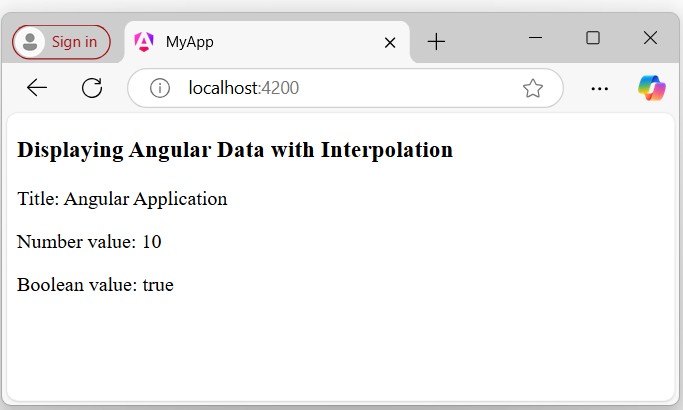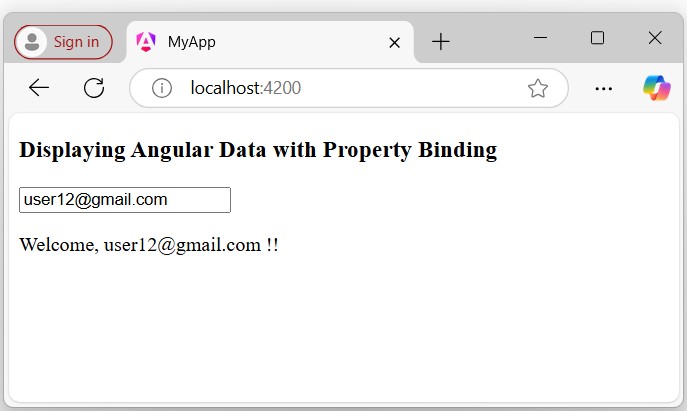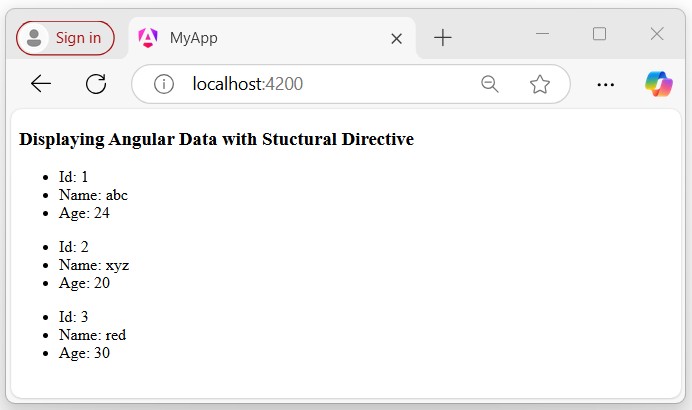
- Angular Tutorial
- Angular - Home
- Angular - Overview
- Angular - Features
- Angular - Advantages & Disadvantages
- Angular Basics
- Angular - Environment setup
- Angular - First Application
- Angular - MVC Architecture
- Angular Components
- Angular - Components
- Angular - Component Lifecycle
- Angular - View Encapsulation
- Angular - Component Interaction
- Angular - Component Styles
- Angular - Nested Components
- Angular - Content projection
- Angular - Dynamic components
- Angular - Elements
- Angular Templates
- Angular - Templates
- Angular - Template statements
- Angular - Template Variables
- Angular - SVG as Templates
- Angular Binding
- Angular - Data Binding
- Angular - Interpolation
- Angular - Event Binding
- Angular - Property Binding
- Angular - Attribute Binding
- Angular - Class Binding
- Angular - Style Binding
- Angular - Two-way Binding
- Angular Directives
- Angular - Directives
- Angular - Attribute Directives
- Angular - Structural Directives
- Angular - Custom Directives
- Angular Pipes
- Angular - Pipes
- Angular - Built-in Pipes
- Angular - Custom Pipes
- Angular Forms
- Angular - Forms
- Angular - Template Driven Forms
- Angular - Reactive Forms
- Angular - Form Validation
- Angular - Dynamic Forms
- Angular Dependency Injection
- Angular - Dependency Injection
- Angular - Injectable Service
- Angular Routing
- Angular - Routing
- Angular - Dynamic Routes
- Angular - Wildcard Routes
- Angular - Nested Routes
- Angular - Navigation
- Angular - Routing in SPA
- Angular - Custom Route Matches
- Angular - Router Reference
- Angular HTTP Client programming
- Angular - Services
- Angular - HTTP Client
- Angular - Request
- Angular - Response
- Angular - GET
- Angular - POST
- Angular - PUT
- Angular - DELETE
- Angular - JSONP
- Angular - CRUD Operations Using HTTP
- Angular Modules
- Angular - Introduction to Modules
- Angular - Root Module
- Angular - Feature Module
- Angular - Sharing Module
- Angular - Routing Module
- Angular - NgModules
- Angular Animation
- Angular - Animations
- Angular Service Workers & PWA
- Angular - Service Workers & PWA
- Angular Testing
- Angular - Testing Overview
- Angular Design Patterns
- Angular - Design Patterns
- Angular - Lazy Loading
- Angular - Singleton Pattern
- Angular - Observer Pattern
- Angular Libraries
- Angular - Libraries
- Angular - Angular Material
- Angular - PrimeNG
- Angular - RxJS
- Angular Advanced
- Angular - Signals
- Angular - Authentication & Authorization
- Angular - Internationalization
- Angular - Standalone Component
- Angular - Accessibility
- Angular - Web Workers
- Angular - Server Side Rendering
- Angular - Ivy Compiler
- Angular - Building with Bazel
- Angular - Backward Compatibility
- Angular - Reactive Programming
- Angular Tools
- Angular - CLI
- Angular Material UI Elements
- Angular - Paginator
- Angular - Datepicker
- Angular - Select Drop-down
- Angular Miscellaneous
- Angular - Third Party Controls
- Angular - Configuration
- Angular - Displaying Data
- Angular - Decorators & Metadata
- Angular - Basic Example
- Angular - Error Handling
- Angular - Testing & Building a Project
- Angular - Lifecycle Hooks
- Angular - User Input
- Angular - What's New?
- Angular Useful Resources
- Angular - Quick Guide
- Angular - Useful Resources
- Angular - Discussion
Angular - Displaying Data
This angular tutorial will discuss the various ways to display data, including how to display array data, object data, variables data, etc. A most common question in the minds of users who have just started learning an angular framework is, how do we display data in angular?
Displaying Data in Angular
Displaying data in Angular involves accessing the properties of a component class and rendering their values in the template. Angular provides various ways to display these data values (including variables, objects, arrays, etc.) in the template (HTML) using features such as interpolation, property binding, and structural directives.
Let's discuss a few different ways to display data in Angular, with appropriate examples to help you understand each of them clearly.
Displaying Data using Interpolation
In Angular, interpolation is one of the most common or basic ways to bind (display) data from your component to the HTML template. It allows you to embed expressions into marked-up text and uses the double curly {{}} as a delimiter.
Syntax
Following is the syntax of interpolation in Angular −
{{ <template expression> }} Here, the template_expression can be any property (variable) of your component.
Example
In this example, we will create properties (variables) named title (string type), num (number type), and isTrue (boolean type). We will bind (display) them in the template using interpolation −
In the app.component.ts, declare the properties with some initial values:
import { Component } from '@angular/core'; @Component({ selector: 'app-root', standalone: true, imports: [], templateUrl: './app.component.html', styleUrl: './app.component.css' }) export class AppComponent { title: string = "Angular Application"; num: number = 10; isTrue: boolean = true; } In the app.component.html, bind the declared properties using interpolation {{}} −
<h3>Displaying Angular Data with Interpolation</h3> <p>{{title}}</p> <p>Number value: {{num}}</p> <p>Boolean value: {{isTrue}}</p> Output
The displayed data will look like this −

Using Property Binding
This is another way to display data using Angular property bindings. In Angular, binding is a "technique" to "bind data between the component and the view".
Example
We create an input field and bind the [value] property to display the component data (i.e., variable "username") within the input field default when the page is loaded −
In the app.component.ts, create a variable named username with the value "user12@gmail.com" −
import { Component } from '@angular/core'; @Component({ selector: 'app-root', standalone: true, imports: [], templateUrl: './app.component.html', styleUrl: './app.component.css' }) export class AppComponent { username: string = "user12@gmail.com"; } In the app.component.html, update the existing code with the code given below −
<h3>Displaying Angular Data with Property Binding</h3> <input type="text" [value]="username"> <p>Welcome, {{username}}!!</p> Output
The output of the above code will look like:

Using Structural Directives
In Angular, structural directives are built-in directives used to control the appearance and behavior of elements in the DOM. They can dynamically add, remove, or manipulate elements based on certain conditions. Common structural directives are:
- *ngIf
- *ngFor
- *ngSwitch
Example
In the example below, we will use the structural *ngFor directive to iterate through the object defined in the component and display all data in the template −
In the app.component.ts, create an array of objects with the keys id, name, and age as follows:
import { CommonModule } from '@angular/common'; import { Component } from '@angular/core'; @Component({ selector: 'app-root', standalone: true, imports: [CommonModule], templateUrl: './app.component.html', styleUrl: './app.component.css' }) export class AppComponent { myData = [ { "id": 1, "name": 'abc', "age": 24 }, { "id": 2, "name": "xyz", "age": 20, }, { "id": 3, "name": "red", "age": 30 } ] } In the app.component.html, use the *ngFor directive to iterate through the object data and display them in the template:
<h3>Displaying Angular Data with Stuctural Directive</h3> <ul *ngFor="let data of myData;"> <li>Id: {{data.id}}</li&t; <li>Name: {{data.name}}</li> <li>Age: {{data.age}}</li> </ul> Output
Following is the output of the above code −

Note! In this tutorial, we have learned the various ways to display data in Angular. There are still more methods that you can explore in individual chapters. This tutorial provided a brief introduction to the concept of displaying data in Angular.